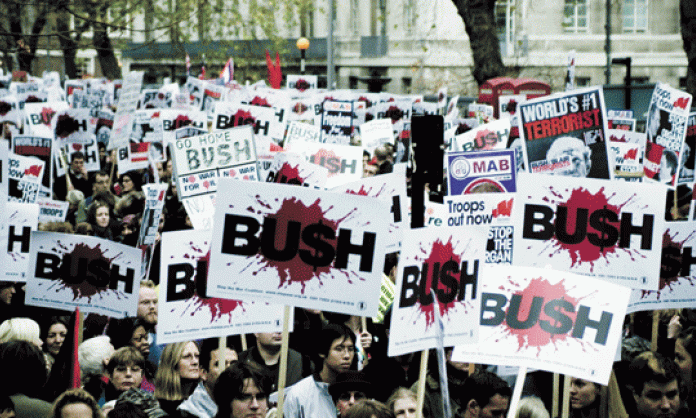The invasion of Iraq in 2003 by the United States and its “coalition of the willing” butchers devastated the country. More than 1 million Iraqis lost their lives. Four million were displaced. US troops, under orders to crush a population resisting occupation, tortured thousands.
Thousands more have been subjected to the same fate by the forces of US-backed Prime Minister Nouri al-Maliki. Sectarian politicians and militias have been bolstered to advance US ruling class geopolitical and economic interests.
Iraq is broken. The crisis now unfolding is the legacy of a long history of violent imperial interventions. It is a sad confirmation that millions of people around the world were right to stand against the US invasion.
Giant protests
Opposition to the Iraq war was historically unprecedented on a number of levels. Never before had a war been so unpopular before it even began. A month before bombs began to rain down on Baghdad, there were giant protests across the world.
A weekend of action in February 2003 was a marvellous display of international coordination. In more than 60 countries, as many as 30 million people voiced their opposition to the impending war.
Melbourne kicked off the global weekend of action on Friday, 14 February. A protest organised by the Victorian Peace Network – a coalition of trade unionists, church leaders, veterans from the anti-Vietnam War and nuclear disarmament movements and the revolutionary left – drew 250,000. From the State Library to Federation Square, Swanston Street was gridlocked as young and old united, chanting “No blood for oil!”
On Sunday 16 February, 500,000 rallied in Sydney’s Hyde Park, while protests took place in nearly every city across the country.
The largest protests occurred in Europe and the UK. As many as 2 million marched in central London. In both Madrid and Barcelona 1 million rallied, making it the biggest protest since the death of Franco, the fascist dictator, in 1975. Rome topped them all with an estimated 3 million taking part in a monster protest. Thirty trains and 3,000 buses were chartered to bring people to the demonstration.
These protesters saw through the torrent of lies that spewed from the mouths of US President George Bush, UK Prime Minister Tony Blair and Australian PM John Howard. We were told the dictator Saddam Hussein was stockpiling chemical and biological weapons and harboured nuclear ambitions. We were told he was connected to the 9/11 attacks on the World Trade Centre.
These lies were backed up by the war-hungry hyenas in the mainstream media. And yet 30 million people protested. So much for elitist arguments that insist ordinary people are too brainwashed by corporate propaganda to understand the truth.
Ruling class war drive
On the back of this outpouring of anti-war sentiment rode a naive optimism. Many thought or perhaps hoped that now that the people had spoken, surely our rulers couldn’t go to war. A New York Times writer enthused: “[T]here may still be two superpowers on the planet: the United States and world public opinion.”
Unfortunately, public opinion teamed with the largest anti-war street marches in history was insufficient to stymie the agenda of the US ruling class. It viewed the war as critical to the project of preserving its position as the unrivalled global superpower. Far from pandering to the lowest common denominator or being slaves to public opinion, governments implement right wing militarist and racist policies because they desire to promote the interests of the minority at the top of society.
This war was not the product of the machinations of a neoconservative cabal having captured the White House or the personal preoccupation of an idiot cowboy from Texas, as was argued at the time. The US war drive from Afghanistan to Iraq was supported by the entire US establishment.
It hoped that an awesome display of firepower would send the right message: that what the US says goes. By reshaping the Middle East and replacing hostile or unreliable regimes with pliant pro-US clients and securing greater control over the region’s oil reserves, it hoped to see off the emergence of any “peer competitors” that could challenge US hegemony.
The failure to stop the war created disillusionment with protest politics. For many, it seemed to confirm the futility of resisting: nothing could change. This is a legacy that we have had to contend with ever since.
We don’t live in a genuine democracy. Through experience, millions learned that the will of the people does not rule. To stop the war, we needed, at the very minimum, a sustained mass protest movement and determined civil disobedience in order to create a political crisis.
The growing discontent in the US army, which was evidenced in small but promising organisations like Iraq Veterans Against the War, needed to develop into open mutiny. The US army disintegrated in Vietnam; it largely held together in Iraq.
Importantly, the millions of workers who marched through the city streets needed to be mobilised as workers, rather than as individuals. To throw down the challenge to Bush and Co. – to squeeze the interests of the Western elite who stood to gain from this war – the movement needed to harness the social power of workers through strike action to paralyse production and the system. We needed to revive the slogan from the struggle against the Vietnam War – “Stop work to stop the war”.
The mass protests on 15 February 2003 and the subsequent campaign to bring the troops home was the indispensable basis on which more radical struggles could potentially have been built. But it wasn’t to be.
Nonetheless, the global movement against the war, combined with the military resistance of the Iraqis to their oppressors, put limits on US military aggression. Having been forced to withdraw after a costly occupation, US imperial wings were clipped.
Today, the eagle doesn’t fly quite so high. Its caution about invading any other country in the Middle East is the positive legacy of its own failure.











